|
 Mucilopilus violaceiporus Mucilopilus violaceiporus
SynonymsPorphyrellus nothofagi
Porphyrellus violaceiporus
Porphyrellus viscidus
Porphyrellus viscidus var. macrosporus
Boletellus violaceiporus
Fistulinella nothofagi
Fistulinella violaceipora
Fistulinella viscida
Mucilopilus nothofagi
Mucilopilus viscidus
Mucilopilus viscidus var. macrosporus
BiostatusPresent in region - Indigenous. Non endemic
Images (click to enlarge)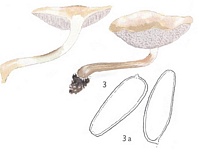
Caption: Plate 2: 3, Boletellus violaceiporus. nat. size: 3a, spores. x 2000.
Owner: PDD | 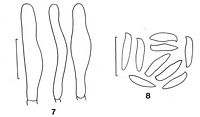
Caption: Fig. 7-8. Porphyrellus nothofagi (Holotype). Fig. 7 Cheilocystidia. Fig. 8 Basidiospores. Standard line = 20 µm. | 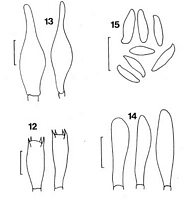
Caption: Figures 12 - 15. Boletellus violaceiporus (holotype). Fig. 12. Basidia. Fig. 13.
Pleurocystidia. Fig. 14. Cheilocystidia. Fig. 15. Basidiospores. Standard line = 20 µm. | 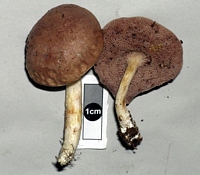
Owner: J.A. Cooper | 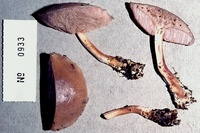
Caption: ZT0933
Owner: E. Horak: © Creative Commons Attribution-Noncommercial 3.0 New Zealand | 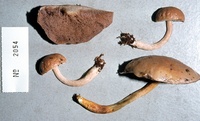
Caption: ZT2054
Owner: E. Horak: © Creative Commons Attribution-Noncommercial 3.0 New Zealand | 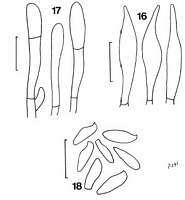
Caption: Figures 16 - 18. Porphyrellus viscidus (holotype). Fig. 16. Pleurocystidia. Fig. 17.
Cheilocystidia. Fig. 18. Basidiospores. Standard line = 20 µm. | 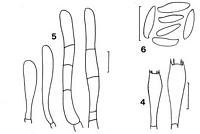
Caption: Figures 4-6. Porphyrellus viscidus var. macrosporus (holotype). Fig. 4. Basidia. Fig. 5. Cheilocystidia. Fig. 6. Basidiospores. Standard line = 20 µm. | 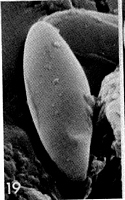
Caption: Scanning electron micrographs of basidiospores. Fig. 19. Porphyrellus visicdus var. macrosporus. | 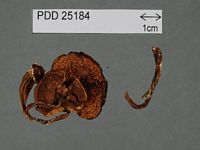
Caption: Dried type specimen
Owner: Herb PDD | 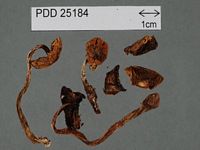
Caption: Dried type specimen
Owner: Herb PDD | 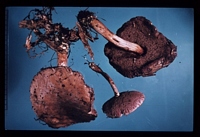
Caption: C-3920
Owner: Herb. PDD | 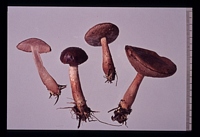
Caption: C-3537
Owner: Herb. PDD | 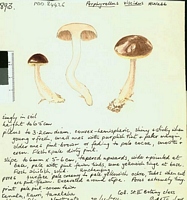
Caption: watercolour
Owner: G.M. Taylor | 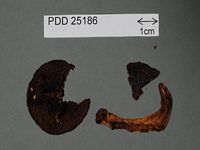
Caption: Dried type specimen
Owner: Herb PDD |
Article: Stevenson, G. (1962) [1961]. The Agaricales of New Zealand: I. Kew Bulletin 15(3): 381–385.
Description: Pileus 4 cm. diam., surface gelatinous to glutinous, pale ochraceous, cuticle of interwoven hyphae; flesh soft, spongy, pale ochraceous. Pores up to 1 mm. diam., tubes 4-6 mm.long, pale violet. Stipe 4-5 cm. X 3-4 mm. tough, cartilagineous, pale fawn at top, darker brown and finely striate below; flesh almost white at top, becoming fawn towards base. Spores 17-18 X 5-6um., thick amber-tinted wall, with an indistinct germ-pore, cystidia not seen.
Habitat: rooting singly in a bank close to Nothofagus solandri stumps, Maitai Valley, 29.4.1956, Stevenson. This appears to be near to, but distinct from, Strobilomyces fusisporus Kawam. described from Japan by Kawamura (1954).
Article: Singer, R. (1978). Notes on bolete taxonomy - II. Persoonia 9(4): 421-438.
Description: 4. The taxonomic position of the genus Fistulinella.
The genus Fistulinella was based on F. staudtii Henn. from Africa. The type of this genus is not,
as was generally assumed (Guzman 1974), lost but has been rediscovered and restudied (Singer
1973) - I agree with Horak (1968) and Guzman (1974) who consider Ixechinus Heim identical
with Fistulinella. I have shown that all pickled material of boletes has separable (`individual')
tubes if the lateral stratum swells up to push the tubes away from each other and if the
mediostratum is sufficiently gelatinized or thin to permit the fluid to dissolve enough of the
gelatinous mass and thus sever the few thin-walled hyphae connecting the two sides of the lateral
strata. Even while growing, some tubes may slide downwards a fraction of a millimeter in relation
to others surrounding them, and thus create an uneven pore level, which emphasizes the false
impression of separate individual `pores' as known in Fistulina. However, a section through the
tubes of dried Fistulinella campinaranae Sing., F. minor (Heim) Guzman, F. venezuelae (Sing.
& Digilio) Sing. and F. violaceiporus (Stevenson) Sing., comb. ined., as studied by me show that
the hymenophoral trama, aside from being somewhat more gelatinized, is not different from other
corresponding structures in Boletaceae and Strobilomycetaceae. The `outer' layer of separated
tubes as removed from hymenophores in liquid preparations consists of a naked lateral stratum
with free hyphae dangling in the medium.
I have (Singer 1975) inserted Fistulinella as a section in Tylopilus, but have insisted that this is a
temporary and tentative solution, waiting for more studies of fresh material. Such fresh material
has been obtained recently from the campinarana vegetation in Brazil. These fresh collections
were prepared as dried herbarium material and thus a continuous tube-layer was maintained. This
species is considered new and most closely related to F. mexicana Guzman. A fraction of the
formalin material on which this latter species, recently published (Guzman, 1974), was based, was
kindly sent to the present author for comparison.
What do the newly discovered species of Fistulinella reveal about the position of this genus, its
limits, and distribution?
In the first place, it appears that all have numerous characters in common and that their distribution
and ecology is totally different from that of Tylopilus as well as the smooth-spored species of
Porphyrellus. Fistulinella is tropical, extending to New Zealand, and non-mycorrhizal, whereas
Tylopilus - although including some tropical species - is predominantly north-temperate and
consistently ectomycorrhizal. Porphyrellus on the other hand, is, as far as smooth-spored species
are concerned, north-temperate but reaching the palaeotropics as well as the Nothofagus zone of
Australia and New Zealand.
Being non-mycorrhizal and narrow-stemmed, with generally very long spores, these often being
pseudoamyloid and/or with apical germ pore, with a spore print in color much like that of
Porphyrellus gracilis, it becomes obvious that Fistulinella is much closer to Porphyrellus than
to Tylopilus. It differs nevertheless by the spores which are smooth and by the strong gelatinization
not only of the hymenophoral trama but also of the surface layers, at least of the pileus, and the
relatively slender stipe.
If we now exclude all species of Porphyrellus which agree in their characteristics with
Fistulinella, we have to transfer the subsection Viscidini and with it the type of section
Pseudotylopili Sing. to Fistulinella and transfer the subsection Niveini to section Graciles of Porphyrellus.
The genus Fistulinella will then be placed side by side with Porphyrellus in the
Strobilomycetaceae, and will contain the following species
F. staudtii Henn.; F. minor (Heim) Guzman, F. major (Heim) Guzman, F. campinaranae Sing. sp. nov., F. mexicana Guzman; F. viscida (McNabb) Sing., comb. nov. [Basionym:
Porphyrellus viscidus McNabb in New Zealand J. Bot. 5: 547. 1967]; F. venezuelae (Sing. &
Digilio) Sing., comb. nov.[Basionym: Tylopilus venezuelae Sing. & Digilio in Lilloa 30: 163.
1960], and obviously also Boletellus violaceiporus Stevenson (type revised).
Article: Wolfe, C.B. (1979). Mucilopilus, a new genus of the Boletaceae, with emphasis on North American taxa. Mycotaxon 10(1): 116-132.
Description: Fruitbodies two. Pilei 2 - 3.5 x 0.3 - 0.5 cm, smooth, uninterrupted, light gold. Stipe 5 - 5.2
x 0.2 - 0.4 cm, equal to subobclavate, concolorous with pileus, smooth. Pileus cuticle an
interwoven ixotrichodermium; terminal cells 2.5 - 6.5 µm diam. (dm = 4 µm), hyaline in
KOH, yellow in Melzer's. Tube trama, hyphae 2.5 - 8 µm diam. (dm = 8 µm), boletoid,
hyaline in KOH, yellow in Melzer's. Clamp connections absent. Basidia 30 - 43 x 10.5 - 13
µm (Dm = 32.5 x 11.5 µm), thin-walled, clavate, hyaline in KOH, yellow in Melzer's.
Pleurocystidia absent; cheilocystidia 19.5 - 47 x 4 - 8 µm (Dm = 34 x 6.5 µm), thin-walled
with a few becoming thick-walled, equal, hyaline in KOH, yellow in Melzer's, abundant
(Fig. 7); caulocystidia 26 - 39 x 5 - 9 µm (Dm = 31 x 8 µm), thin-walled, equal to clavate,
hyaline to pale yellow in KOH, yellow in Melzer's. Spores 14 - 19.5 x 4 - 5 µm (Dm = 17 x
5 µm; E = 2.8 - 5.0; Em = 3.5), elliptical to subfusiform, inequilateral by a shallow
suprahilar depression and adaxial swelling, pale yellow-cinnamon with green refractile
inclusions in KOH, yellow-rust (pale dextrinoid) in Melzer's; surface smooth, walls
continuous, surrounded by a hyaline membrane (Fig. 8); in deposit "Russet", light brown.
Notes: Observations. The ixotrichodermium of the pileus, the equal cheilocystidia, and the long,
narrow spores (Em = 3.5) clearly indicate this specimen as being very similar to B. conicus,
T. venezuelae, B. violaceiporus, and P. viscidus; this taxon differs from the other taxa in
this genus by the absence of pleurocystidia. Because this taxon belongs in the genus
Mucilopilus, the following new combination is proposed.
Mucilopilus nothofagi (McNabb) Wolfe, comb. nov.
Basionym: Porphyrellus nothofagi McNabb. 1967. New Zealand J. Bot. 5(4): 543.
Article: Wolfe, C.B. (1979). Mucilopilus, a new genus of the Boletaceae, with emphasis on North American taxa. Mycotaxon 10(1): 116-132.
Description: Fruitbody one. Pileus 2 x 0.4 cm, light yellow-brown, continuous, glabrous. Hymenium
rust-brown. Stipe 4 x 0.3 cm, equal, smooth. Pileus cuticle a palisade ixotrichodermium;
terminal cells 4 - 6.5 µm diam. (dm = 6.5 µm), equal, hyaline in KOH, yellow in Melzer's.
Tube trama hyphae 2.5 - 8 µm diam. (d = 5 µm), boletoid, hyaline in KOH, yellow in
Melzer's. Clamp connections absent. Basidia (19.5-) 26 - 34 x 8 - 10.5 µm (Dm = 30 x 9
µm), thin-walled, clavate to narrowly clavate to subequal, hyaline in KOH, yellow in
Melzer's, some with a slight central constriction (Fig. 12). Pleurocystidia 52 - 65 x 13 - 17
µm (Dm = 58.5 x 13 µm), thin-walled, broadly fusoid ventricose, hyaline in KOH, yellow in
Melzer's, rare (Fig. 13); cheilocystidia 23.5 - 37.5 x 5 - 9 (-11.5) µm (Dm = 32.5 x 8 µm),
thin-walled, equal to subventricose to clavate, hyaline in KOH, yellow in Melzer's, in
chains of 2 - 3 cells (Fig. 14); caulocystidia (19.5-) 26 - 35 (-39) x 5 - 8 µm (Dm = 30 x 6.5
µm), thin-walled, clavate, yellow in KOH, gold in Melzer's, some with a thick refractile
apex. Spores 13 - 18 (-21) x 4 - 6.5 µm (Dm = 17 x 5 um; E = 2.8 - 3.7; Em = 3.2), fusoid,inequilateral by a distinct suprahilar depression and adaxial swelling, pale ochraceous
green in KOH, pale yellow-rust (sub dextrinoid) in Melzer's (Fig. 15); surface smooth (Fig.
21), walls continuous, surrounded by a hyaline membrane.
Notes: Observations. The violet pallid color of the hymenophore is characteristic of this taxon.
Since it belongs in the genus Mucilopilus, the following new combination is proposed.
Mucilopilus violaceiporus (Stevenson) Wolfe, comb. nov.
Basionym: Boletellus violaceiporus Stevenson. 1962. Kew Bull. 15(3): 384.
Article: Wolfe, C.B. (1979). Mucilopilus, a new genus of the Boletaceae, with emphasis on North American taxa. Mycotaxon 10(1): 116-132.
Description: Fruitbodies two. Pilei 0.8 - 3.0 x 0.3 - 0.5 cm, vinaceous brown to yellow-brown, glabrous,
appears to have been viscid when fresh. Stipe 1.8 - 3 x 0.3 - 0.6 cm, obclavate, khaki
overall, faintly reticulate at the apex only. Pileus cuticle an interwoven ixotrichodermium;
terminal cells 4 - 6.5 µm diam. (dm = 4 µm), equal to subclavate, hyaline in KOH, yellow in
Melzer's. Tube trama hyphae 4 - 9 µm diam. (dm = 6.5 µm), hyaline in KOH, yellow in IKI.
Clamp connections absent. Basidia 23.5 - 36.5 x 9 - 13 µm (Dm = 28.5 x 10.5 µm), thin-walled, clavate, 2 - 4 sterigmate, hyaline.in KOH, yellow in Melzer's. Pleurocystidia 43 -
58.5 x 8 - 9 µm (Dm = 56 x 9 µm), narrowly fusoid-ventri cose, hyaline in KOH, yellow in
Melzer's (Fig. 16); cheilocystidia 24.5 - 54.5 x 6.5 - 10.5 µm (Dm = 41.5 x 8 µm), equal to
subclavate, hyaline to pale yellow-tan in KOH, yellow in Melzer's, with an occasional
distal secondary septum, abundant and clustered around the pores (Fig. 17); caulocystidia
39 - 69 x 6.5 - 9 µm (Dm = 52 x 8 µm), equal to clavate, scattered, pale yellow in KOH,
gold-brown to dingy brown in Melzer's. Spores 14.5 - 19.5 x 4 - 5 (-6.5) µm (Dm = 17 x 5
um; E = 2.4 - 4.6; Em = 3.5), elliptical to fusiform, inequilateral by a broad shallow
suprahilar depression and adaxial swelling, yellow green with cinnamon walls in KOH,
rust-yellow in Melzer's (Fig. 18); surface smooth, with a small and obscure inner wall
discontinuity, surrounded by a hyaline membrane; in deposit "Russet", light brown.
Notes: Observations. Wolfe & Petersen (1978) published SEM's of the spores of this specimen
which show the spore surface as smooth. Furthermore, the hymenophore at maturity is
pallid flesh color. Because this specimen is the type specimen of the type species of the
genus Mucilopilus, the following new combination is proposed.
Mucilopilus viscidus (McNabb) Wolfe, comb. nov.
Basionym: Porphyrellus viscidus McNabb. 1967. New Zealand J. Bot. 5(4): 543.
Article: Wolfe, C.B. (1979). Mucilopilus, a new genus of the Boletaceae, with emphasis on North American taxa. Mycotaxon 10(1): 116-132.
Description: Fruitbody one. Pileus 3 x 0.3 cm, surface glabrous, smooth, uninterrupted, appears to have
been viscid when fresh, vinaceous brown, pores gelatinized. Stipe 5 x 0.7 cm, obclavate,
yellow-tan to khaki with minute pruina scattered over the surface. Pileus cuticle an
interwoven ixotrichodermium; terminal cells 2.5 - 5 µm diam. (dm = 4 µm), equal, hyaline
in KOH, yellow in Melzer's. Tube trams, hyphae 4 - 6.5 µm diam. (d = 5 µm), boletoid,
hyaline in KOH, yel low in Melzer's, some appearing subgelatinous. Clamp connections
absent. Basidia 32.5 - 41.5 x 8 - 10.5 µm (Dm = 35 x 9 µm), thin-walled, clavate, 2 - 4
sterigmate, hyaline in KOH, yellow in Melzer's (Fig. 4). Pleurocystidia 43 - 53.5 x 9 - 12
µm (Dm = 52 x 9 µm), thin-walled, fusoid-ventricose, hyaline in KOH, yellos in Melzers,
rare; cheilocystidia 54.4 - 93.5 x 5 - 8 µm (Dm = 65 x 6.5 µm), thin-walled, subclavate to
equal, occasionally with a secondary septum, hyaline in KOH, yellow in Melzer's (Fig. 5);
caulocystidia 23.5 - 78 x 6.5 - 9 µm (Dm = 39 x 8 µm), thin-walled, equal to obclavate,
fasciculate, opaque cream in KOH, yellow in Melzer's, occasionally with a recurved distal
end. Spores 15.5 - 24.5 x 4 - 8 µm (Dm = 19.5 x 5 µm; E = 3 - 4.8; Em = 3.8), elliptical to narrowly elliptical, inequilateral by a narrow suprahilar depression and adaxial swelling,
yellow-khaki with green refractile contents in KOH, yellow to yellow-rust (dextrinoid) in
Melzer's (Fig. 6); surface smooth (Fig. 19), inner distal wall discontinuity, surrounded by a
hyaline membrane; in deposit "Russet", light brown.
Notes: Observations. This specimen is very similar to P. viscidus var. viscidus McNabb by the
presence of the ixotrichodermium, basidial and cystidial characters. Spores of this
specimen are longer by 5 µm (at the upper range limit) and by 2.5 µm at the Lm value that
var. viscidus. The spore Em value is also greater than that of var. viscidus by 0.3. The spore character differences appear to be sufficiently different for varietal recognition. More
studies of general collections will be necessary for confirmation of this conclusion.
Because this taxon belongs in the genus Mucilopilus the following new combination is
proposed.
Mucilopilus viscidus var. macrosporus (McNabb) Wolfe, comb. nov.
Basionym: Porphyrellus viscidus var. macrosporus McNabb. 1967. New Zealand J. Bot. 5:
546.
|